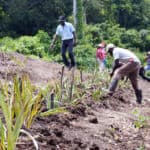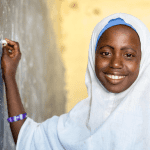Achieving the SDGs in the World’s Most Vulnerable Countries: Why the Private Sector Must Recommit to Financing Sustainable Development in Small Island Developing States
At the 2023 SDG Summit during this year’s UN General Assembly in September, member states adopted a political declaration reaffirming their commitment to the Agenda for Sustainable Development — and acknowledging that halfway through the 2030 Agenda, the world is not on track to reach the Sustainable Development Goals (SDGs). Many countries are falling further behind, with Small Island Developing States (SIDS), in particular, facing greater gaps to SDG achievement than the rest of the world due to structural economic, geophysical and environmental vulnerabilities.
The shortfall in financing for sustainable development is among the main reasons why the 2030 Agenda is at risk of failure around the world. And this lack of funding is especially problematic in poor and vulnerable countries, including SIDS. As the world doubles down on achieving the Agenda by 2030, it’s clear that the private sector must step up its commitment to financing progress toward the SDGs in these countries. The upcoming COP 28 climate conference and the 2024 International Conference on SIDS, which takes place in Antigua and Barbuda in May, provide critical opportunities for countries — and stakeholders within the private sector — to commit to concrete financing plans to overcome SIDS’ obstacles to achieving the SDGs.
Severe SDG financing constraints and lower SDG performance in SIDS
Small Island Developing States face significant challenges to SDG achievement for a number of reasons.
First, SIDS are characterized by a high degree of structural vulnerability. This can be defined across three dimensions: economic (e.g., exposure to unforeseen, external economic and financial shocks); developmental (e.g., geophysical constraints, such as smallness and remoteness); and environmental (e.g., exposure to natural hazards and climate change). Even though structural vulnerability is not the sole determinant of SDG outcomes, a recent study we at the UN Sustainable Development Solutions Network conducted shows that highly vulnerable countries face greater challenges in pursuit of sustainable development compared to other countries. Indeed, according to the Multidimensional Structural Vulnerability Index — a new tool we introduced to assess the structural vulnerability faced by 180 countries worldwide, including 33 SIDS — SIDS are the most vulnerable countries in the world across all three dimensions, and are also the farthest behind on SDG progress.
Moreover, because of these vulnerabilities which have been exacerbated by recent cascading crises, SIDS have limited capacity to invest in long-term and resilient development, contributing to their severe SDG financing gaps. Making matters worse, international development aid is insufficient to respond to these SDG financing shortfalls. The Organisation for Economic Cooperation and Development’s Development Assistance Committee has a long-standing target recommending that its member countries dedicate 0.7% of their gross national income to official development assistance (ODA). But this target is not ambitious enough to solve sustainable development challenges, and in 2022, countries were only committing around half of the funding the target calls for. Additionally, ODA is unevenly distributed across countries. Some of the world’s most vulnerable economies, including SIDS, receive very little aid as a share of total ODA, around 3.1% in 2021. And they often struggle to access additional development finance due to their income level, which is higher than the existing eligibility criteria based solely on income indicators.
While private financing could stand as a solution, SIDS frequently face an uphill battle to mobilize private capital. For example, they receive only 0.6% of global foreign direct investment flows. Moreover, in global capital markets, poor and vulnerable countries are unable to borrow sufficient capital to meet their long-term sustainable development needs. This is due to high perceived risks, and misalignments in time horizons between private investors in search of short-term financial returns and countries seeking to meet their own long-term SDG financing needs.
Private Sector Solutions to the SDG Financing Gap in SIDS
There are a number of solutions to these challenges which could enhance SIDS’ access to private finance.
For starters, the current credit rating system must be reformed so that it better serves the needs of SIDS and other vulnerable countries. The existing commercial credit rating methodologies are based solely on short-term liquidity considerations. As a result, SIDS are frequently subjected to high borrowing costs and short maturities on debts. Recent sovereign credit rating data show that most SIDS either have ratings in the speculative and risky range or have no disclosed ratings. Instead, investment grade credit scores must consider the long-term growth potential of countries — SIDS, for example, with their exclusive economic zones, hold nearly 30% of the world’s oceans and seas, highlighting their growth potential as “large ocean states” that can leverage fisheries, tourism and other benefits of the “blue economy.” And the positive spillovers (e.g., developed human capital and core physical infrastructures) arising from increased investment in sustainable development should ultimately lead to significant changes in private investors’ perception of risks and the length of their investments in these countries.
In addition, the private sector should mobilize innovative financing mechanisms tailored more to country-specific vulnerabilities and needs. Public-private partnerships, for example, can be particularly useful in countries characterized by high economic and/or developmental vulnerability. By financing large-scale infrastructure projects in priority sectors, such as ICT, transport, agriculture, tourism and renewable energy, these partnerships can provide high-quality, cost-effective solutions to SIDS’ economic and developmental vulnerabilities, including smallness, remoteness, limited availability of freshwater resources, and high dependency on food and fuel imports.
Other innovative financing mechanisms, such as blue bonds — i.e., debt instruments that aim to raise capital from private investors to finance marine and ocean-based projects — can help provide financing to economies with significant environmental vulnerabilities. In SIDS, for example, blue bonds could be an important tool for financing projects that address the impacts of climate change. In 2018, the Republic of Seychelles launched the world’s first sovereign blue bond to support sustainable marine and fisheries projects. More recently, in 2021, Belize announced the issuance of a blue bond to scale up ocean conservation and address urgent biodiversity losses through improved ocean management. A similar initiative was also launched in 2022 by the government of Barbados to secure and protect the country’s marine environment. Insurance mechanisms that allow resources to be rapidly disbursed to impacted countries in the wake of economic or natural shocks could also be a potential solution, though these are still very scarce in most SIDS.
However, despite the need for more private capital, the private sector’s role in helping vulnerable countries — particularly SIDS — achieve the SDGs should not be limited solely to financing and investment. Fostering capacity building, spurring innovation, and introducing technical information and technological inputs in targeted countries are equally important. One key area in which the private sector should further enhance its role is the data revolution. Private companies, such as insurance firms, often have access to vast and granular data on the impacts of natural hazards and other critical factors. By sharing this data, the private sector can empower governments and local entities to better assess risks, develop resilience and respond effectively to the challenges of a rapidly changing world, ultimately fostering more sustainable and resilient communities.
If the world hopes to achieve the SDGs by 2030 — without leaving SIDS behind — these and other solutions must be explored and implemented. Without a renewed commitment from investors and other private sector players, the SDG Agenda will fall further out of reach.
Isabella Massa is a Senior Economist and Samory Toure is a Program Associate at the UN Sustainable Development Solutions Network (SDSN).
Photo courtesy of UNDP Climate.
- Categories
- Environment, Investing



